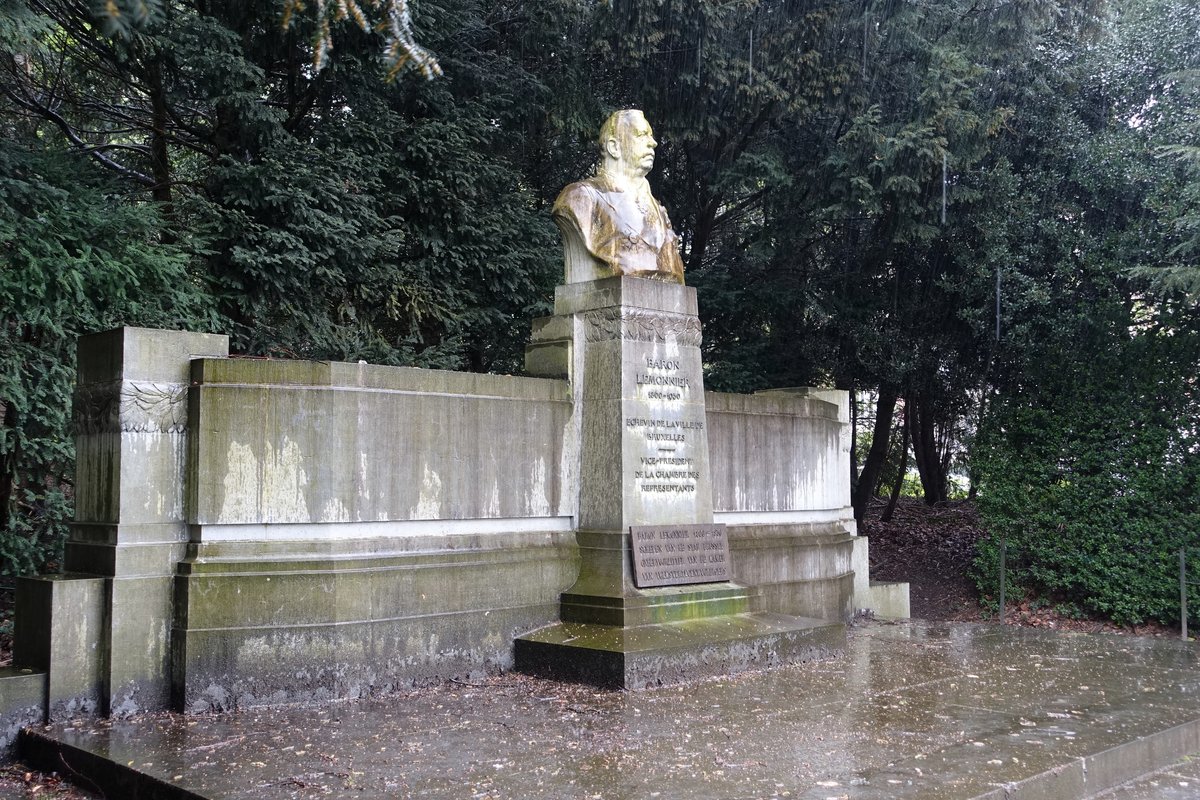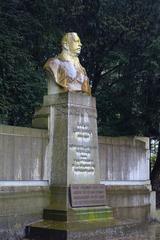
Baron Lemonnier Visiting Hours, Tickets, and Guide to Brussels’ Historical Sites
Date: 14/06/2025
Introduction: The Legacy of Baron Lemonnier in Brussels
Brussels, the cosmopolitan capital of Belgium, is renowned for its dynamic blend of history, art, and multicultural vibrancy. Among the city’s celebrated figures, Baron Maurice Lemonnier stands out as a pivotal leader whose vision helped shape the city’s modern identity. From the marble bust on Avenue Franklin Roosevelt to the lively Boulevard Maurice Lemonnier and the symbolic statue on Avenue de Cérès, these landmarks collectively honor Lemonnier’s enduring legacy as a liberal politician, wartime mayor, and advocate for urban modernization.
This guide provides a detailed overview for visitors interested in exploring the Baron Lemonnier monuments and neighboring historical sites. You’ll find practical information on locations, visiting hours, accessibility, guided tours, and nearby attractions—plus essential travel tips and resources to enhance your Brussels experience. Whether you’re drawn by architectural heritage, cultural life, or the city’s vibrant markets, this guide will help you make the most of your visit. (Monument Heritage Brussels, Local Guide Brussels, Wikipedia - Boulevard Maurice Lemonnier)
Table of Contents
- Introduction: The Legacy of Baron Lemonnier in Brussels
- Historical Background: Baron Maurice Lemonnier’s Civic Contributions
- Baron Lemonnier Monuments and Memorials
- Visiting Information
- Boulevard Maurice Lemonnier: Urban Evolution and Cultural Life
- Practical Visitor Tips
- Nearby Attractions
- Frequently Asked Questions (FAQ)
- Additional Resources and References
Historical Background: Baron Maurice Lemonnier’s Civic Contributions
Baron Maurice Lemonnier (1860–1930) was a distinguished Belgian lawyer, mining engineer, and liberal politician who served as mayor of Brussels from 1914 to 1917. His leadership was especially significant during World War I, when he stepped in as acting mayor during the German occupation, defending the city’s autonomy and supporting modernization efforts. Lemonnier’s tenure saw the development of new neighborhoods, improved public utilities, expanded educational facilities, and better housing for workers. His vision for a modern Brussels is still visible in the city’s urban landscape and civic institutions. (Wikipedia, fr.wikipedia)
Baron Lemonnier Monuments and Memorials
Statue at Avenue de Cérès
Located at Avenue de Cérès 080, 1000 Brussels, this monument sits amidst well-tended gardens in a district celebrated for its elegant blend of historic and contemporary architecture. Erected to honor Lemonnier’s service and leadership, the statue is accessible to the public year-round and is especially photogenic between 8:00 AM and 8:00 PM.
- Open 24/7
- Admission: Free
- Accessibility: Wheelchair accessible with paved paths
- Guided Tours: Available via city tour operators; see Visit Brussels
- Special Events: Check Brussels city event calendars for commemorative activities
Marble Bust on Avenue Franklin Roosevelt
This dignified marble bust, sculpted by Frans Huygelen in 1932, marks the intersection of Avenue Franklin Roosevelt, Avenue de Cérès, and Avenue Lloyd George. It is a legally protected monument recognized for its artistic and historical value. The setting, surrounded by mature trees and landscaped gardens, provides a tranquil space for reflection and photography.
- Open air; accessible 24/7
- Admission: Free
- Accessibility: Flat, well-maintained grounds suitable for all visitors
Boulevard Maurice Lemonnier
Boulevard Maurice Lemonnier, renamed in 1919 to honor the Baron’s contributions, is a dynamic urban artery connecting Gare du Midi with the city center. It features neoclassical architecture, commercial activity, and a lively multicultural atmosphere. The boulevard’s design is part of Brussels’ 19th-century urban renewal, replacing the old Senne River and medieval streets with modern, grand avenues (Wikipedia - Boulevard Maurice Lemonnier).
Visiting Information
Hours, Tickets, and Accessibility
- All Baron Lemonnier monuments are open-air and accessible at all times
- No entry fee or ticket required
- Wheelchair accessible paths and ramps
- Public transport: Metro, tram, and bus lines serve the area (Lemonnier station; close to Gare du Midi and Brussels Central)
Guided Tours and Special Events
- Walking tours of Brussels’ city center often include the Boulevard and monuments; check Visit Brussels for schedules
- Occasional commemorative events and cultural activities occur near the monuments, especially on national holidays
Boulevard Maurice Lemonnier: Urban Evolution and Cultural Life
Historical Evolution and Planning
Boulevard Maurice Lemonnier was constructed between 1868 and 1871, part of a city-wide modernization project that transformed Brussels’ lower town. The initiative, led by architect Léon Suys and Mayor Jules Anspach, replaced the polluted Senne River with grand boulevards inspired by Parisian urbanism (Wikipedia: Central Boulevards of Brussels). The boulevard symbolizes Brussels’ shift from cramped medieval quarters to a modern European capital.
Architectural Highlights
Walking the boulevard, visitors encounter a harmonious mix of neoclassical residences, commercial spaces, and public buildings. Notable landmarks include the Midi Palace, Charles Buls Primary School (formerly the Model School), and Haute École Francisco Ferrer. The area integrates with Place Anneessens and Place Fontainas, both hubs of local activity (Local Guide Brussels).
Markets and Social Hubs
Boulevard Maurice Lemonnier is known for its multicultural markets and commercial vibrancy:
- Marché du Midi: Every Sunday, one of Europe’s largest outdoor markets, offering produce, textiles, and street food
- Anneessens Market: Tuesday mornings and Sunday bicycle markets
- Local Bookshops: Bibliopolis and Pêle-Mêle are favorites among locals and visitors
Pedestrian Zones and Urban Renewal
Since 2015, the boulevard has become increasingly pedestrian-friendly, with widened sidewalks, public art, and green spaces. This urban renewal encourages walking and cycling, making it an inviting area for both residents and tourists (Wikipedia: Central Boulevards of Brussels).
Practical Visitor Tips
- Best Visit Times: Spring and summer for pleasant weather; Sunday mornings for vibrant market life
- Transport: Use metro, tram, or bus to Lemonnier station; cycling is easy with Villo! bike-sharing
- Safety: Generally safe by day; as in any city, be mindful of pickpockets in busy markets and on public transport (brussels.com)
- Etiquette: Greet shopkeepers, use basic French or Dutch, and round up bills as a gesture of appreciation
Nearby Attractions
- Grand Place: UNESCO-listed central square with ornate guildhalls (Visit Brussels)
- BELvue Museum: Belgian history and culture
- Comic Strip Murals: Celebrating Belgium’s comic heritage
- Marolles District: Known for its flea market and bohemian atmosphere
- Bois de la Cambre Park: Tranquil green space near Avenue Franklin Roosevelt
- Mont des Arts and Sablon District: Museums, panoramic views, antiques, and chocolatiers
Frequently Asked Questions (FAQ)
Q: Are there entrance fees for the Baron Lemonnier monuments?
A: No; all are free, outdoor public sites.
Q: What are the best market days?
A: Sunday mornings for Marché du Midi; Tuesday mornings for Anneessens Market.
Q: Is the area accessible for those with limited mobility?
A: Yes; smooth pavements, ramps, and accessible public transit.
Q: Are there guided tours focused on Baron Lemonnier?
A: Many walking tours include the monuments; check with local tour operators or Visit Brussels.
Q: Is the neighborhood safe for visitors?
A: Generally yes, especially during the day. Use standard urban precautions.
Additional Resources and References
- Visit Brussels
- Local Guide Brussels
- Monument Heritage Brussels
- Brussels Remembers
- Wikipedia - Boulevard Maurice Lemonnier
- Wikipedia - Central Boulevards of Brussels
- Brussels.com Travel Tips
Plan your visit to the Baron Lemonnier monuments and Boulevard Maurice Lemonnier for an immersive journey through Brussels’ rich history, vibrant urban life, and enduring civic spirit. Download the Audiala app for interactive guides, personalized itineraries, and the latest updates on Brussels’ cultural events.




































































































































